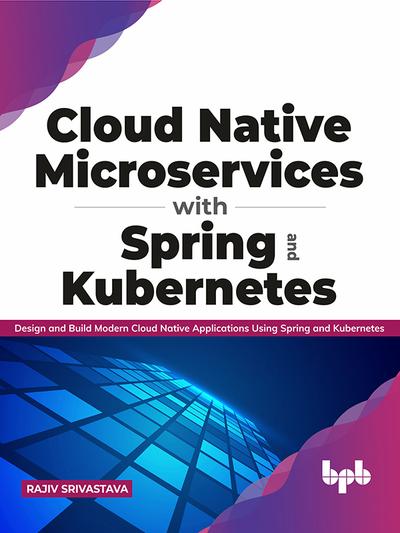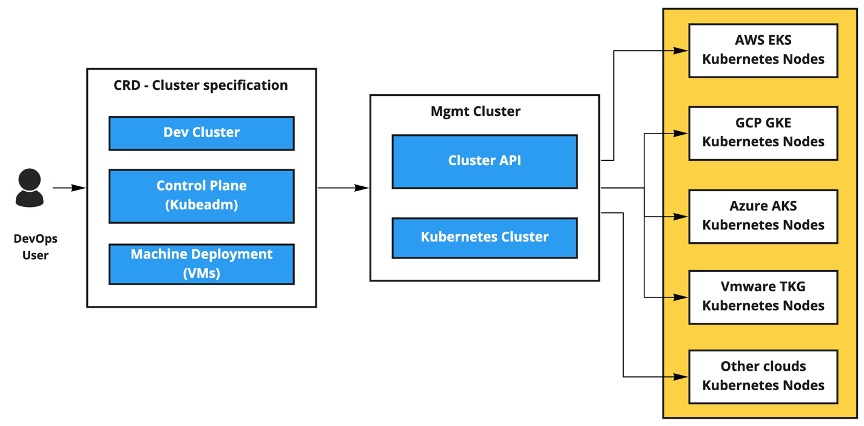I am happy to announce release of my first book “Cloud Native Microservices with Spring and Kubernetes” with BPB Publications!! It’s all about design, build and deploy scalable cloud native microservices on container using the Spring framework and Kubernetes. Need your support! Please buy and review this book on Amazon. Also, share book detail with your IT software engineers colleagues and friends.
The main objective of this book is to give an overview of cloud-native microservices, their architecture, design patterns, best practices, use cases, and practical coverage of modern applications. This book covers a strong understanding of microservices, API first approach, Testing, Observability, API Gateway, Service Mesh, and Kubernetes alternatives of Spring Cloud. This book covers the implementation of various design patterns of developing cloud native microservices using Spring framework, docker and Kubernetes. It also covers containerization concepts and hands-on code exercises.
After reading this book, the readers will have a holistic understanding of building, running, and managing cloud native microservices applications on Kubernetes containers.
It’s the first book on this subject in India by any Indian writer, which is also economical than foreign publications. This book is about learning of software application design and development using Microservices, Spring and Kubernetes based technologies. It’s useful for software developers, cloud engineers, DevOps and technical architects.
Available on:
This book is available in paperback and Kindle (eBook on free Kindle app on Android/iOS/Laptop/Desktop) editions on amazon and BPB in most of the countries of North America, Europe, the Middle East, Asia, and Africa.
Refer free preview and TOC/Index of this book:
https://drive.google.com/drive/folders/1Lq280d6hUcyh2xm8cFuyt1vADNzk61dg?usp=sharing
What you will learn:
- Learn fundamentals of microservice and design patterns.
- Perform end-to-end microservices testing using Cucumber.
- Learn microservices development using Spring Boot and Kubernetes.
- Learn to develop reactive, event-driven, and batch microservices.
- Perform end-to-end microservices testing using Cucumber.
- Implement API gateway, authentication & authorization, load balancing, caching, and rate limiting.
- Learn observability and monitoring techniques of microservices
Who this book is for:
This book is for the Spring Developers, Microservice Developers, Cloud Engineers, DevOps Consultants, Technical Architect and Solution Architects.
Table of Contents (Chapters):
1. Overview of Cloud Native microservices
2. Microservice design patterns
3. API first approach
4. Build microservices using the Spring Framework
5. Batch microservices
6. Build reactive and event-driven microservices
7. The API gateway, security, and distributed caching with Redis
8. Microservices testing and API mocking
9. Microservices observability
10. Containers and Kubernetes overview and architecture
11. Run microservices on Kubernetes
12. Service Mesh and Kubernetes alternatives of Spring Cloud
KEY FEATURES:
- Complete coverage on how to design, build, run, and deploy modern cloud native microservices.
- Includes numerous sample code exercises on microservices, Spring and Kubernetes.
- Develop a stronghold on Kubernetes, Spring, and the microservices architecture.
- Complete guide of application containerization on Kubernetes containers.
- Coverage on managing modern applications and infrastructure using observability tools.
Chapter 1: Overview of Cloud Native microservices, introduces cloud native modern applications, cloud first overview, benefits, types of clouds, classification, and the need for cloud native modern applications. It will cover detailed microservices (MSA ) overview, characteristics, motivations, benefits, best practices, architecture principles, challenges and solutions, application modernization spectrum, twelve-factor apps, and beyond twelve-factor apps.s
Chapter 2: Microservice design patterns, introduces various microservices design patterns with use cases, advantages, and disadvantages.
Chapter 3: API first approach, discusses fundamentals of the API first approach. It discusses details of the REST overview, API model, best practices, design principles, components, security, communication protocols, and how to document dynamically with OpenAPI Swagger. It discusses API design planning, specifications, API management tools, and testing API with SwaggerHub inspector and PostMan REST client.
Chapter 4: Build microservices using the Spring Framework, is a key chapter of Spring Boot and Spring Cloud components with hands-on lab exercises. It will cover steps to build microservice using the REST API framework. It covers the Spring Cloud config server and resiliency of microservices practical aspects.
Chapter 5: Batch microservices, introduces batch microservices, use cases, Spring Cloud Task, and Spring Batch. It discusses hands-on lab exercises using Spring Cloud Data Flow (SCDF) and Kafka. It also discusses a few Spring batch practices, auto-scaling techniques, batch orchestration, and compositions methods for sequential or parallel batch processing. Last but not the least; it talks about alerts and monitoring of Spring Cloud Task and Spring Batch.
Chapter 6: Build reactive and event-driven microservices, describes building of reactive microservices, non-blocking synchronous APIs, and event-driven asynchronous microservices. It covers steps to develop sample reactive microservices with Spring’s project Reactor, Spring WebFlux, and event-driven asynchronous microservices. It discusses Spring Cloud Stream, Zookeeper, SpringBoot, and overview of Kafka. It also covers hands-on lab exercises of event-driven asynchronous microservices using Spring Cloud Stream and Kafka.
Chapter 7: API gateway, security, and distributed caching with Redis, introduces the API Gateway overview, features, advantages, and best practices. It covers hands-on lab exercises to expose REST APIs of microservices externally with the Spring Cloud Gateway. It covers distributed caching overview and hands-on lab exercises using Redis. It discusses API gateway rate limiting and Implementation of API gateway rate limiting with Redis and Spring Boot. Last but not the least, it covers best practices of API Security. Implementation of SSO using Spring Cloud Gateway, Spring Security, Oauth2, Keycloak, OpenId, and JWT tokens.
Chapter 8: Microservices testing and API mocking, describes important aspects of microservices testing practices, challenges, benefits, testing strategy, testing pyramid, and different types of microservices testing. It covers implementation of the integration testing framework using Behavioral Driven Development (BDD) with hands-on code examples. It also discusses microservices testing tools and best practices of microservices testing. It covers the role of testing in the microservices CI/CD pipeline. Last but not the least; it talks about API mocking and hands-on lab implementation with the WireMock framework.
Chapter 9: Microservices observability, covers detail observability and monitoring overview and techniques of microservices with the Spring actuator, micrometer health APIs, and Wavefront APM. It covers application logging overview, best practices, simple logging, and log aggregation of distributed microservices with implementation using Elasticsearch, Fluentd, and Kibana (EFK) on the Kubernetes container. It discusses the need of APM performance and telemetry monitoring tools for distributed microservices and how to trace multiple microservices in a distributed environment. It also covers hands-on lab implementation of monitoring microservices with Prometheus and Grafana.
Chapter 10: Containers and Kubernetes overview and architecture, is a key chapter which introduces containers, docker, docker engine containerization, Buildpacks, components of docker files, build docker files, run docker files, and inspect docker images. It covers docker image registry and how to persist docker images in image container registries. It covers an overview of Kubernetes, need, and architecture. Last but not the least; it covers a detailed introduction of Kubernetes resources.
Chapter 11: Run microservices on Kubernetes, discusses practical aspects of Kubernetes, installation, and configuration with monitoring and visualization tools with Octant and Proxy. It discusses how to create and manage Kubernetes clusters in detail. It discusses hands-on exercises of creating docker images of Java microservices, pushing it to the Docker hub container image registry, and deploying to Kubernetes clusters. It covers hands-on lab examples of exposing API endpoints of microservices outside the Kubernetes cluster by using the Nginx ingress controller. Last but not the least; it covers various popular and useful Kubernetes application deployment and configuration of management tools.
Chapter 12: Service Mesh and Kubernetes alternatives of Spring Cloud, covers a detailed overview and benefits of GitOps and Service Mesh. It covers the Istio Service Mesh architecture and deployment of microservices on Kubernetes with Argo CD. Last but not the least; it discusses various Kubernetes alternatives of Spring Cloud projects and popular cloud buzzwords!
About the Author
Rajiv Srivastava is the founder of cloudificationzone.com, which is a cloud native modern application tech blog site. He is a cloud solution architect and modern application specialist with 17+ years of work experience in software development and architectural design.
KEYWORDS
1. Spring framework
2. API first approach
3. Cloud Native
4. Microservices observability
5. API testing
6. API gateway
7. Microservices observability
8. Service mesh
9. API gateway
10. Redis distributed caching
11. Kafka
12. Spring Cloud
13. Service discovery
14. Spring cloud data flow
15. Ingress controller






